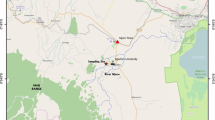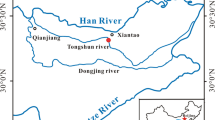Abstract
Pathogenic bacteria are a serious public health concern. Exposure to these microorganisms can result in illnesses or even death. Therefore, it is important to control pathogenic bacteria sources, transport mechanisms and fate. Best management practices proved to be very effective in the control of non-point source pollution. In this study, the soil and water assessment tool (SWAT) was modified and used to simulate the fecal coliform in Chao River of Miyun Reservoir watershed, China. The model was then used to explore the effectiveness of vegetative filter strips (VFS) in reducing fecal coliform abundance throughout the watershed. The water temperature equation within the SWAT was modified to align the model more closely with the characteristics of the study area and generate a more accurate simulation. The DAFSratio (20, 50, 80, 120 and 150) and DFcon (0.25, 0.4, 0.6 and 0.75) parameters were considered for VFS to see their effects on removal efficiency. The results show that calibration and validation results for fecal coliform and flow can be accepted. Different values for DAFSratio and DFcon have great influence on VFS. Increasing values resulted in a decrease in the removal efficiency of VFS.


Similar content being viewed by others
Explore related subjects
Discover the latest articles, news and stories from top researchers in related subjects.References
Abbaspour KC (2011) SWAT-CUP4: SWAT calibration and uncertainty programs—a user manual. Department of Systems Analysis, Integrated Assessment and Modelling (SIAM), Eawag, Swiss Federal Institute of Aquatic Science and Technology, CH, Switzerland
ASAE (2000) Standard D384.1 manure production and characteristics. American Society of Agricultural Engineers, St. Joseph
Baffaut C (2006) Little Sac River watershed fecal coliform total maximum daily load. FAPRI‐UMC Report No. 11‐06. Food and Agricultural Policy Research Institute, University of Missouri, Columbia
Baffaut C, Benson VW (2009) Modeling flow and pollutant transport in a karst watershed with SWAT. Trans ASAE 52(2):469–479
Baffaut C, Sadeghi A (2010) Bacteria modeling with SWAT for assessment and remediation studies: a review. Trans ASAE 53(5):1585–1594
Benham BL, Baffaut C, Zeckoski RW, Mankin KR, Pachepsky YA, Sadeghi AM, Brannan KM, Soupir ML, Habersack MJ (2006) Modeling bacteria fate and transport in watersheds to support TMDLS. Trans ASAE 49(4):987–1002
Bougeard M, Le Saux JC, Perenne N, Baffaut C, Robin M, Pommepuy M (2011) Modeling of Escherichia coli fluxes on a catchment and the impact on coastal water and shellfish quality. J Am Water Resour Assoc 47(2):350–366
Cardoso F, Shelton D, Sadeghi A, Shirmohammadi A, Pachepsky Y, Dulaney W (2012) Effectiveness of vegetated filter strips in retention of Escherichia coli and Salmonella from swine manure slurry. J Environ Manage 110:1–7
Cheng S, Song HT (2009) Conservation buffer systems for water quality security in South to North Water Transfer Project in China: an approach review. Front For China 4(4):394–401
Cho KH, Pachepsky YA, Kim JH, Kim JW, Park MH (2012) The modified SWAT model for predicting fecal coliforms in the Wachusett Reservoir Watershed, USA. Water Res 46:4750–4760
Coffey R, Cummins E, Flaherty VO, Cormican M (2010) Analysis of the soil and water assessment tool (SWAT) to model Cryptosporidium in surface water sources. Biosyst Eng 106:303–314
Entry JA, Hubbard RK, Thies JE, Fuhrmann JJ (2000) The influence of vegetation in riparian filterstrips on coliform bacteria: II. Survival in soils. J Environ Qual 29(4):1215–1224
Fox GA, Matlock EM, Guzman JA, Sahoo D, Stunkel KB (2011) Escherichia coli load reduction from runoff by vegetative filter strips: a laboratory-scale study. J Environ Qual 40(3):980–988
Frey SK, Topp E, Edge T, FallC GannonV, Jokinen C, Marti R, Neumann N, Ruecker N, Wilkes G, Lapen DR (2013) Using SWAT, bacteroidales microbial source tracking markers, and fecal indicator bacteria to predict waterborne pathogen occurrence in an agricultural watershed. Water Res 47:6326–6337
Hyer KE, Moyer DL (2003) Patterns and sources of fecal coliform bacteria in three streams in Virginia, 1999–2000. US Geological Survey, Water-Resources Investigations Report No. 03-4115. U.S. Geological Survey, Washington, DC
Kim JW, Pachepsky YA, Shelton DR, Coppock C (2010) Effect of streambed bacteria release on E. coli concentrations: monitoring and modeling with the modified SWAT. Ecol Model 221:1592–1604
Lewis DJ, Atwill ER, Lennox MS, Pereira MD, Miller WA, Conrad PA, Tate KW (2010) Management of microbial contamination in storm runoff from california coastal dairy pastures. J Environ Qual 39(5):1782–1789
Maringanti C, Chaubey I, Arabi M, Engel B (2008) A multi-objective optimization tool for the selection and placement of BMPs for pesticide control. Hydrol Earth Syst Sci Discuss 5:1821–1862
Middleton JH, Ambrose A (2005) Enumeration and antibiotic resistance patterns of fecal indicator organisms isolated from migratory Canada geese (Branta canadensis). J Wildl Dis 41(2):334–341
Moore JA, Smyth JD, Baker ES, Miner JR, Moffitt DC (1989) Modeling bacteria movement in livestock manure systems. Trans ASAE 32(3):1049–1053
Moyer DL, Hyer KE (2003) Use of the hydrological simulation program—FORTRAN and bacterial source tracking for development of the fecal coliform total maximum daily load (TMDL) for Christians Creek, Augusta County, Virginia. Water-Resources Investigations Report No. 03-4162. U.S. Geological Survey, Washington, DC
Parajuli PB, Mankin KR, Barnes PL (2007) New methods in modeling source-specific bacteria at watershed scale using SWAT. In: Proceedings of the watershed management to meet water quality standards and total maximum daily load (TMDLs). ASABE Publication No. 701P0207. ASABE, St. Joseph
Parajuli PB, Mankin KR, Barnes PL (2008) Applicability of targeting vegetative filter strips to abate fecal bacteria and sediment yield using SWAT. Agric Water Manage 95:1189–1200
Parajuli PB, Mankin KR, Barnes LP (2009) Source specific fecal bacteria modeling using soil and water assessment tool model. Bioresour Technol 100:953–963
Pilgrim JM, Fang X, Stefan HG (1998) Stream temperature cortelations with air temperatures in Minnesota: implications for climate warming. J Am Water Resour Assoc 34(5):1109–1121
Shen Z, Chen L, Xu L (2013) A topography analysis incorporated optimization method for the selection and placement of best management practices. Plos One 8(1):e54520. doi:10.1371/journal.pone.0054520
Shen ZY, Qiu JL, Hong Q, Chen L (2014) Simulation of spatial and temporal distributions of non-point source pollution load in the Three Gorges Reservoir Region. Sci Total Environ 493:138–146
Stefan HG, Preud’Homme EB (1993) Stream temperature estimation from air temperature. J Am Water Resour Assoc 29(1):27–45
Wang SF, Wang XK, Ouyang ZY (2012) Effects of land use, climate, topography and soil properties on regional soil organic carbon and total nitrogen in the upstream watershed of Miyun Reservoir, North China. J Environ Sci 24(3):387–395
White MJ, Arnold JG (2009) Development of a simplistic vegetative filter strip model for sediment and nutrient retention at the field scale. Hydrol Process 23:1602–1616
WHO/UNICEF (2000) Global water supply and sanitation assessment 2000 report (online). World Health Organization and United Nations Children’s Fund, New York
Yang Q, Tam NFY, Wong YS, Luan TG, Su WS, Lan CY et al (2008) Potential use of mangroves as constructed wetland for municipal sewage treatment in Futian, Shenzhen, China. Mar Pollut Bull 57:735–743
Zheng CC, Zhou LX (2013) Antibacterial potency of housefly larvae extract from sewage sludge through bioconversion. J Environ Sci 25(9):1897–1905
Acknowledgments
The research was funded by National Natural Science Foundation of China (No. 51579011), National Science Foundation for Innovative Research Group (No. 51421065) and State Key Program of National Natural Science of China (No. 41530635).
Author information
Authors and Affiliations
Corresponding author
Rights and permissions
About this article
Cite this article
Bai, J., Shen, Z. & Yan, T. Effectiveness of vegetative filter strips in abating fecal coliform based on modified soil and water assessment tool. Int. J. Environ. Sci. Technol. 13, 1723–1730 (2016). https://doi.org/10.1007/s13762-016-1011-6
Received:
Revised:
Accepted:
Published:
Issue Date:
DOI: https://doi.org/10.1007/s13762-016-1011-6




